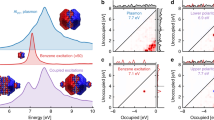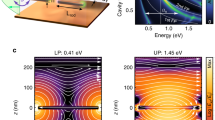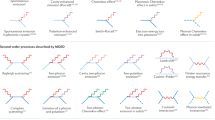Abstract
In the regime of deep strong light–matter coupling, the coupling strength exceeds the transition energies of the material1,2,3, fundamentally changing its properties4,5; for example, the ground state of the system contains virtual photons and the internal electromagnetic field gets redistributed by photon self-interaction1,6. So far, no electronic excitation of a material has shown such strong coupling to free-space photons. Here we show that three-dimensional crystals of plasmonic nanoparticles can realize deep strong coupling under ambient conditions, if the particles are ten times larger than the interparticle gaps. The experimental Rabi frequencies (1.9 to 3.3 electronvolts) of face-centred cubic crystals of gold nanoparticles with diameters between 25 and 60 nanometres exceed their plasmon energy by up to 180 per cent. We show that the continuum of photons and plasmons hybridizes into polaritons that violate the rotating-wave approximation. The coupling leads to a breakdown of the Purcell effect—the increase of radiative damping through light–matter coupling—and increases the radiative polariton lifetime. The results indicate that metallic and semiconducting nanoparticles can be used as building blocks for an entire class of materials with extreme light–matter interaction, which will find application in nonlinear optics, the search for cooperative effects and ground states, polariton chemistry and quantum technology4,5.
This is a preview of subscription content, access via your institution
Access options
Access Nature and 54 other Nature Portfolio journals
Get Nature+, our best-value online-access subscription
$29.99 / 30 days
cancel any time
Subscribe to this journal
Receive 51 print issues and online access
$199.00 per year
only $3.90 per issue
Buy this article
- Purchase on Springer Link
- Instant access to full article PDF
Prices may be subject to local taxes which are calculated during checkout




Similar content being viewed by others
Data availability
The measured and simulated optical spectra that support the current study are available at https://doi.org/10.17169/refubium-26819. Source data are provided with this paper.
References
Ciuti, C., Bastard, G. & Carusotto, I. Quantum vacuum properties of the intersubband cavity polariton field. Phys. Rev. B 72, 115303 (2005).
Bayer, A. et al. Terahertz light-matter interaction beyond unity coupling strength. Nano Lett. 17, 6340–6344 (2017).
Yoshihara, F. et al. Superconducting qubit-oscillator circuit beyond the ultrastrong-coupling regime. Nat. Phys. 13, 44–47 (2017).
Frisk Kockum, A., Miranowicz, A., De Liberato, S., Savasta, S. & Nori, F. Ultrastrong coupling between light and matter. Nat. Rev. Phys. 1, 19–40 (2019); publisher correction 1, 295 (2019).
Forn-Díaz, P., Lamata, L., Rico, E., Kono, J. & Solano, E. Ultrastrong coupling regimes of light–matter interaction. Rev. Mod. Phys. 91, 025005 (2019).
De Liberato, S. Light-matter decoupling in the deep strong coupling regime: the breakdown of the Purcell effect. Phys. Rev. Lett. 112, 016401 (2014).
Baranov, D. G., Wersäll, M., Cuadra, J., Antosiewicz, T. J. & Shegai, T. Novel nanostructures and materials for strong light-matter interactions. ACS Photon. 5, 24–42 (2018).
Li, X. et al. Vacuum Bloch–Siegert shift in Landau polaritons with ultra-high cooperativity. Nat. Photon. 12, 324 (2018).
Rossatto, D. Z., Villas-Bôas, C. J., Sanz, M. & Solano, E. Spectral classification of coupling regimes in the quantum Rabi model. Phys. Rev. A 96, 013849 (2017).
Kockum, A. F., Miranowicz, A., Macrì, V., Savasta, S. & Nori, F. Deterministic quantum nonlinear optics with single atoms and virtual photons. Phys. Rev. A 95, 063849 (2017).
Garziano, L. et al. One photon can simultaneously excite two or more atoms. Phys. Rev. Lett. 117, 043601 (2016).
Hutchison, J. A., Schwartz, T., Genet, C., Devaux, E. & Ebbesen, T. W. Modifying chemical landscapes by coupling to vacuum fields. Angew. Chem. Int. Ed. 51, 1592–1596 (2012).
Nataf, P. & Ciuti, C. Protected quantum computation with multiple resonators in ultrastrong coupling circuit QED. Phys. Rev. Lett. 107, 190402 (2011).
Romero, G., Ballester, D., Wang, Y. M., Scarani, V. & Solano, E. Ultrafast quantum gates in circuit QED. Phys. Rev. Lett. 108, 120501 (2012).
Askenazi, B. et al. Midinfrared ultrastrong light-matter coupling for THz thermal emission. ACS Photon. 4, 2550–2555 (2017).
Forn-Díaz, P. et al. Ultrastrong coupling of a single artificial atom to an electromagnetic continuum in the nonperturbative regime. Nat. Phys. 13, 39–43 (2017).
Chen, P.-Y., Soric, J. & Alù, A. Invisibility and cloaking based on scattering cancellation. Adv. Mater. 24, OP281–OP304 (2012).
Joannopoulos, J. D., Johnson, S. G., Winn, J. N. & Meade, R. D. Photonic Crystals: Molding the Flow of Light 2nd edn (Princeton Univ. Press, 2008).
Maier, S. Plasmonics: Fundamentals and Applications (Springer, 2007).
Halas, N. J., Lal, S., Chang, W.-S., Link, S. & Nordlander, P. Plasmons in strongly coupled metallic nanostructures. Chem. Rev. 111, 3913–3961 (2011).
Yannopapas, V., Modinos, A. & Stefanou, N. Optical properties of metallodielectric photonic crystals. Phys. Rev. B 60, 5359–5365 (1999).
Huang, C.-P., Yin, X.-G., Wang, Q.-J., Huang, H. & Zhu, Y.-Y. Long-wavelength optical properties of a plasmonic crystal. Phys. Rev. Lett. 104, 016402 (2010).
Park, D. J. et al. Plasmonic photonic crystals realized through DNA-programmable assembly. Proc. Natl Acad. Sci. USA 112, 977–981 (2015).
Lamowski, S. et al. Plasmon polaritons in cubic lattices of spherical metallic nanoparticles. Phys. Rev. B 97, 125409 (2018).
Hopfield, J. J. Theory of the contribution of excitons to the complex dielectric constant of crystals. Phys. Rev. 112, 1555–1567 (1958).
Hanske, C. et al. Large-scale plasmonic pyramidal supercrystals via templated self-assembly of monodisperse gold nanospheres. J. Phys. Chem. C 121, 10899–10906 (2017).
Matricardi, C. et al. Gold nanoparticle plasmonic superlattices as surface-enhanced Raman spectroscopy substrates. ACS Nano 12, 8531–8539 (2018).
Lau, C. Y. et al. Enhanced ordering in gold nanoparticles self-assembly through excess free ligands. Langmuir 27, 3355–3360 (2011).
Ross, M. B., Ku, J. C., Vaccarezza, V. M., Schatz, G. C. & Mirkin, C. A. Nanoscale form dictates mesoscale function in plasmonic DNA-nanoparticle superlattices. Nat. Nanotechnol. 10, 453 (2015).
Sun, L., Lin, H., Kohlstedt, K. L., Schatz, G. C. & Mirkin, C. A. Design principles for photonic crystals based on plasmonic nanoparticle superlattices. Proc. Natl Acad. Sci. USA 115, 7242–7247 (2018).
Schulz, F., Tober, S. & Lange, H. Size-dependent phase transfer functionalization of gold nanoparticles to promote well-ordered self-assembly. Langmuir 33, 14437–14444 (2017).
Ye, X. et al. Structural diversity in binary superlattices self-assembled from polymer-grafted nanocrystals. Nat. Commun. 6, 10052 (2015).
Mueller, N. S. et al. Dark interlayer plasmons in colloidal gold nanoparticle bi- and few-layers. ACS Photon. 5, 3962–3969 (2018).
Mueller, N. S. et al. Direct optical excitation of dark plasmons for hot electron generation. Faraday Discuss. 214, 159–173 (2019).
De Liberato, S. Virtual photons in the ground state of a dissipative system. Nat. Commun. 8, 1465 (2017).
Rivera, N., Kaminer, I., Zhen, B., Joannopoulos, J. D. & Soljačić, M. Shrinking light to allow forbidden transitions on the atomic scale. Science 353, 263–269 (2016).
Purcell, E. M., Torrey, H. C. & Pound, R. V. Resonance absorption by nuclear magnetic moments in a solid. Phys. Rev. 69, 37–38 (1946).
Ciuti, C. & Carusotto, I. Input-output theory of cavities in the ultrastrong coupling regime: the case of time-independent cavity parameters. Phys. Rev. A 74, 033811 (2006).
Günter, G. et al. Sub-cycle switch-on of ultrastrong light–matter interaction. Nature 458, 178–181 (2009).
Artoni, M. & Birman, J. L. Quantum-optical properties of polariton waves. Phys. Rev. B 44, 3736–3756 (1991).
Bastús, N. G., Comenge, J. & Puntes, V. Kinetically controlled seeded growth synthesis of citrate-stabilized gold nanoparticles of up to 200 nm: size focusing versus Ostwald ripening. Langmuir 27, 11098–11105 (2011).
Zheng, Y., Zhong, X., Li, Z. & Xia, Y. Successive, seed-mediated growth for the synthesis of single-crystal gold nanospheres with uniform diameters controlled in the range of 5–150 nm. Part. Part. Syst. Charact. 31, 266–273 (2014).
Dong, A., Chen, J., Vora, P. M., Kikkawa, J. M. & Murray, C. B. Binary nanocrystal superlattice membranes self-assembled at the liquid-air interface. Nature 466, 474–477 (2010).
Olmon, R. L. et al. Optical dielectric function of gold. Phys. Rev. B 86, 235147 (2012).
Yu, P. & Cardona, M. Fundamentals of Semiconductor Physics (Springer, 1996).
Mihailovic, M. et al. Optical and excitonic properties of ZnO films. Opt. Mater. 31, 532–536 (2009).
Liu, N. et al. Three-dimensional photonic metamaterials at optical frequencies. Nat. Mat. 7, 31–37 (2007).
Nicolson, A. M. & Ross, G. F. Measurement of the intrinsic properties of materials by time- domain techniques. IEEE Trans. Instrum. Meas. 19, 377–382 (1970).
Rakić, A. D. Algorithm for the determination of intrinsic optical constants of metal films: application to aluminum. Appl. Opt. 34, 4755–4767 (1995).
Acknowledgements
We are grateful to A. Knorr, G. Weick and S. De Liberato for discussions and comments. We thank M. Wolf for the use of the supercontinuum light source. This work was supported by the European Research Council (ERC) under grant DarkSERS (772108). S.R. acknowledges the Focus Area NanoScale of Freie Universität Berlin. F.S. was supported by the DFG via project SCHU 3019/2-1. H.L. and F.S. acknowledge support by the Cluster of Excellence ‘Advanced Imaging of Matter’ of the DFG (EXC 2056, project 390715994). B.G.M.V. acknowledges the Coordenação de Aperfeiçoamento de Pessoal de Nivel Superior (CAPES) for financial support under the programme PDSE (grant number 88881.134611/2016-01) and Dahlem Research School (DRS). E.B.B. and B.G.M.V. acknowledge financial support from CNPq, CAPES (finance code 001) and FUNCAP (PRONEX PR2-0101-00006.01.00/15).
Author information
Authors and Affiliations
Contributions
S.R. and N.S.M. conceived and designed the research project. The gold nanoparticle crystals were synthesized by F.S. and H.L.; the characterization and optical experiments were performed by N.S.M., Y.O., F.S. and S.J. The analytical theory and FDTD simulations were developed by N.S.M., B.G.M.V., E.B.B. and S.R. The data were analysed by N.S.M., F.S. and S.R.; S.R. and N.S.M. wrote the initial draft of the manuscript, on which all co-authors commented.
Corresponding author
Ethics declarations
Competing interests
The authors declare no competing interests.
Additional information
Peer review information Nature thanks Junichiro Kono, Salvatore Savasta and the other, anonymous, reviewer(s) for their contribution to the peer review of this work.
Publisher’s note Springer Nature remains neutral with regard to jurisdictional claims in published maps and institutional affiliations.
Extended data figures and tables
Extended Data Fig. 1 Plasmon dispersion without light–matter interaction, calculated with a microscopic theory based on the point-dipole approximation and the Drude model24 (see Methods).
The following parameters were used: fcc crystal, nanoparticle diameter d = 30 nm, interparticle gap size a = 2 nm, ħωp = 9.07 eV, ε∞ = 1 and εm = 1.96. The plasmonic band structure was calculated using \({\omega }_{{\rm{pl}}}({\bf{k}})={\omega }_{{\rm{NP}}}\sqrt{1+{\rm{g}}f({\bf{k}})}\), where we set ft = −4/3 and fl = 8/3 close to the Γ point because of a divergence of the lattice sums; see discussion in ref. 24. The oscillations close to Γ are an artefact of the calculations and were omitted when calculating the polariton dispersion in Fig. 1b.
Extended Data Fig. 2 SEM images of gold nanoparticle crystals with large crystallites.
a, Gold nanoparticle crystal consisting of 30-nm gold nanoparticles. b, Gold nanoparticle crystal consisting of 59-nm gold nanoparticles. The scale bars are 1 μm.
Extended Data Fig. 3 Simulated optical transmission of aluminium nanoparticle fcc crystals.
The crystals consist of six layers of d = 30 nm nanoparticles with gaps a = 2 nm (black), 5 nm (cyan) and 10 nm (magenta). The dielectric constant of the embedding medium was set to εm = 1.96 and the optical properties of aluminium were modelled using a fit of the experimental data from Rakić49.
Extended Data Fig. 4 Approximations of the Hopfield Hamiltonian.
a, Vacuum Bloch–Siegert shift, ΔVBS, calculated from the difference between the polariton dispersion of the full Hamiltonian (black line in Fig. 4a) and the dispersion of the Hamiltonian when neglecting all counter-rotating terms (orange line in Fig. 4a). b, Fitting of experimental data (d = 59 nm) with the polariton dispersions of the interaction Hamiltonians discussed in Supplementary Information. The black line is a fit with the Hopfield model (Supplementary Information equation (S8)). The pink line shows a fit with the polariton dispersion when neglecting the A2 term (Supplementary Information equation (S9)). The orange line is a fit with the dispersion when neglecting all counter-rotating (CR) terms (no CR terms; Supplementary Information equation (S11)). The blue line is a fit with the RWA approximation (no CR terms and no A2 term; Supplementary Information equation (S12)).
Extended Data Fig. 5 Mean population of the ground state with virtual photons and virtual plasmons as a function of the wave vector k.
Extended Data Fig. 6 Absorption spectra calculated from the Hopfield Hamiltonian for ultrastrong to deep strong coupling.
The absorption by the lower polariton branch increases in intensity and decreases in line width, and vice versa for the upper polariton branch. The normalized coupling strength is η = 0.5−2.0 and varies in increments of ∆η = 0.05 (ħωNP = 4.06 eV, \({\omega }_{{\rm{pl}}}^{{\rm{t}}}=\sqrt{{\omega }_{{\rm{NP}}}^{2}-4{\varOmega }_{{\rm{R}}}^{2}/3}\), slab thickness 100 nm and γ = 5 × 1013 rad s−1). The model is discussed in Methods.
Extended Data Fig. 7 Evaluation of nanoparticle diameter d and interparticle gap a using a TEM image of a 59-nm nanoparticle monolayer.
a, TEM image of a monolayer of gold nanoparticles. b, Evaluation of nanoparticle sizes and interparticle gap sizes of the image in a using the software Image J. The software determines the size of the nanoparticles (coloured areas), giving the mean nanoparticle diameter. The interparticle gaps sizes were obtained by subtracting the particle diameters from the nearest-neighbour distances (white lines). c, Histogram of the nanoparticle diameters and fit with a Gaussian distribution. The mean values from the analysis of the TEM image in a are d = 60.6 nm and a = 1.5 nm. The scale bars are 100 nm.
Extended Data Fig. 8 Simulated plasmon-polariton dispersions for gold nanoparticle fcc crystals with different diameters d and interparticle gap sizes a.
The labels show d and a in nanometres. a, Dispersions for different nanoparticle diameters and an interparticle gap size of 2 nm. b, Dispersions for different gap sizes and a nanoparticle diameter of 50 nm. The data points were obtained from simulated absorption spectra and the solid lines are fits with equation (1) using ΩR and \({\omega }_{{\rm{pl}}}^{{\rm{t}}}\) as fitting parameters.
Extended Data Fig. 9 Comparison of polariton dispersions from the microscopic model (solid black lines) and FDTD simulations (data points).
a, The polariton dispersion shown in Fig. 1b with d = 30 nm, a = 2 nm and εm = 1.96. b, Parameters as in a, except for εm = 1. c, Polariton dispersion for d = 30 nm, a = 20 nm and εm = 1.96. We used the Drude model as the dielectric function of the metallic nanoparticles with ε ∞= 1, ħωp = 9.07 eV and ħγp = 40 meV.
Extended Data Fig. 10 Effect of crystal thickness on the coupling strength.
a, Simulated polariton dispersion for an fcc gold nanoparticle crystal with d = 50 nm, a = 2 nm and εm = 1.96. The data points were obtained by fitting the absorption spectra of crystals with different numbers of layers. The black line is a fit of the data points for 20 layers with the Hopfield dispersion (equation (1)). The inset shows the normalized coupling strength as a function of layer number. b, As in a, but for the experimental data of the gold nanoparticle crystal with d = 41 nm. The black line is a fit of the data points for 5–7 layers.
Supplementary information
Supplementary Information
The Supplementary Information contains a Supplementary Table with all variables used in the manuscript and Supplementary Discussion on the Hopfield model.
Source data
Rights and permissions
About this article
Cite this article
Mueller, N.S., Okamura, Y., Vieira, B.G.M. et al. Deep strong light–matter coupling in plasmonic nanoparticle crystals. Nature 583, 780–784 (2020). https://doi.org/10.1038/s41586-020-2508-1
Received:
Accepted:
Published:
Issue Date:
DOI: https://doi.org/10.1038/s41586-020-2508-1
This article is cited by
-
Mode-multiplexing deep-strong light-matter coupling
Nature Communications (2024)
-
Dynamical control of nanoscale light-matter interactions in low-dimensional quantum materials
Light: Science & Applications (2024)
-
High-quality nanocavities through multimodal confinement of hyperbolic polaritons in hexagonal boron nitride
Nature Materials (2024)
-
Efficient bosonic nonlinear phase gates
npj Quantum Information (2024)
-
Ultrastrong exciton-plasmon couplings in WS2 multilayers synthesized with a random multi-singular metasurface at room temperature
Nature Communications (2024)
Comments
By submitting a comment you agree to abide by our Terms and Community Guidelines. If you find something abusive or that does not comply with our terms or guidelines please flag it as inappropriate.



